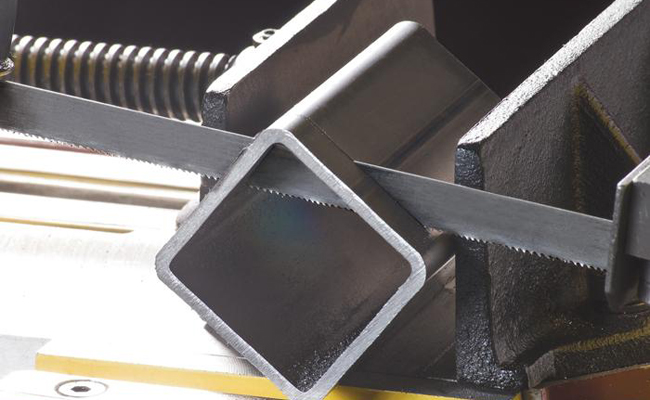BS-500G Automatic Band Saw
Cutting Capacity :
In the field of metal processing, an excellent band saw often determines the level of production efficiency. As an indispensable equipment in modern factories, industrial band saws are reshaping the process of metal cutting with their high efficiency and precision. This article will give you an in-depth understanding of the advantages, purchase points and usage tips of this equipment.

Why is the industrial band saw the first choice for metal processing?
Compared with traditional cutting methods, industrial band saws have shown incomparable advantages:
Cutting efficiency has been significantly improved: a medium-sized band saw can cut dozens of meters of metal materials per hour, which is 5-8 times faster than traditional manual sawing. After introducing a band saw, an automotive parts manufacturer reduced the working hours of its cutting process by 70%.
Material waste is greatly reduced: the incision width of the band saw blade is usually only 1-2mm, saving 15-20% of material compared to a circular saw. For precious metal processing, this means considerable cost savings.
Stable and reliable cutting quality: Modern band saws are equipped with precise guide systems, and the flatness of the cutting surface can reach ±0.1mm/m, which fully meets the requirements of most precision machining.
High degree of automation: The new CNC band saw can realize the full process of automatic feeding, automatic clamping, and automatic cutting, and one operator can manage multiple devices at the same time.
Key considerations for purchasing industrial band saws
Faced with a wide range of band saw products on the market, how to choose the equipment that suits your needs? The following are several core considerations:
1. Select the model according to the material type
Cutting ordinary carbon steel: standard band saws are competent
Cutting alloy steel and stainless steel: high-power, low-speed models are required
Cutting thin-walled pipes: models with special clamps should be selected to prevent deformation
2. Cutting capacity matches production needs
Maximum cutting height: determines the maximum size of the processable material
Cutting angle range: general models provide 0-45° adjustment, special needs need to be customized
Cutting speed range: different materials require different optimal cutting speeds
3. Core component quality inspection
Saw blade guide system: determines cutting accuracy and service life
Hydraulic system: affects equipment stability and maintenance cycle
Control system: key to human-machine interaction experience of CNC machines
Mr. Wang, purchasing supervisor of a mechanical processing plant, shared his experience: “When we updated the equipment last year, we paid special attention to after-sales service and spare parts supply. Even the best machine will inevitably need maintenance, and fast after-sales service can minimize the loss of production stoppage.”
Industrial band saw machine use and maintenance skills
Proper operation and maintenance can not only extend the life of the equipment, but also ensure the cutting quality:
Operation specification:
Check the saw blade tension before starting the machine, generally controlled at 250-300N/mm2
Adjust the feed speed according to the material thickness. Too fast feed will cause early wear of the saw blade
Use appropriate clamps when cutting special-shaped materials to avoid material movement affecting accuracy
Daily maintenance points:
Clean up chips regularly, Especially the accumulated chips in the guide block and saw wheel
Check the hydraulic oil level and oil quality every week, and replace the hydraulic oil every 2000 hours
Lubricate and maintain the guide rails and lead screws every shift
Saw blade selection and use:
For carbon steel materials, use saw blades with 10-14 teeth per inch
For alloy steel, use carbide saw blades with appropriately reduced tooth pitch
New saw blades need to be “run-in cut”, and 50% of the normal feed should be used for the first 20 cuts
Mr. Li, the technical director of a metal products factory, pointed out: “We have extended the average service life of band saw blades from the original 8 hours to 15 hours through standardized operation and regular maintenance, which alone saves $10,000 in consumables costs each year.”
Technical development trend of industrial band saw machines
With the development of intelligent manufacturing, band saw machine technology is also constantly innovating:
Intelligent control: The new generation of band saw machines is equipped with an adaptive control system that can automatically adjust cutting parameters according to the hardness of the material to achieve the best cutting effect.
Internet of Things integration: The equipment operation data is uploaded to the cloud in real time, which can realize remote monitoring, fault warning and maintenance reminders.
Energy-saving and environmentally friendly design: With high-efficiency motors and energy recovery systems, energy consumption is reduced by more than 30% compared with traditional models.
Multi-function integration: Some high-end models integrate automatic measurement, marking and other functions to achieve one-stop processing.
For small and medium-sized enterprises with limited budgets, industry experts recommend that you consider purchasing second-hand equipment with stable performance. An equipment dealer said: “The price of a professionally refurbished second-hand band saw machine is only 40-60% of that of a new machine, while the performance can reach more than 80% of that of a new machine, which is very cost-effective.”
As the basic equipment for metal processing, the selection and use of industrial band saw machines directly affects the production efficiency and product quality of enterprises. By understanding the characteristics of the equipment, mastering the operating skills and keeping up with the development trend of technology, enterprises can maximize the value of the equipment and gain an advantage in the fierce market competition.
Cutting Capacity :
Cutting Capacity :